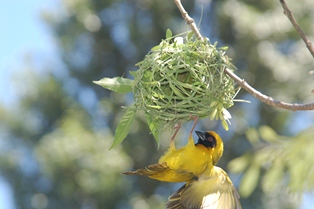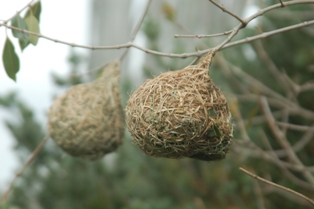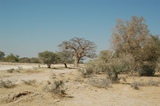Interesting sightings and answers to your queries about weavers
Send your query or unusual photos to Dieter: weavers4africa [at] gmail.com
|
2011-11-07
A friend was in Johannesburg this weekend and had been watching a particular nest in a colony of Masked Weavers. It appears that there was an almost fledged chick in a nest (it was fully feathered), which the parents had been feeding up until last night. A heavy storm broke out and the observers feared for the life of the chick as the nest was taking strain from the storm. This morning the chick was lying dead beneath the nest and a male was busy ripping the said nest apart. The questions are ... 1. Had the chick been knocked from the nest during the storm? 2. Had the male evicted and killed the chick? 3. Why was he ripping the nest apart? 4. Is this normal behavior? I would think that the chick did fall out during the storm - once on the ground, it would die very quickly from exposure to the storm.
Out of interest, the male does not roost in a nest with eggs or chicks. The female sleeps in the nest with her eggs and chicks, although I'm not sure if she stays in the nest the last day or two before the (large) chicks fledge.

Male Southern Masked Weaver displaying from a new nest See breeding records for Southern Masked Weavers here. |
|
2010-06-29
What is the reason why Sociable Weavers are linked to areas below 600 mm per annum rainfall? (Jean-Pierre Le Roux) The Sociable Weaver has a remarkable communal nest built of dry grass. If this species built its nest in high rainfall areas, their nests would become water-logged and quickly disintegrate. Arid areas can experience heavy showers on rare occasions but usually the Sociable Weaver nests have plenty of opportunity to dry out. Sociable Weavers do need some rain and slightly higher rainfall can result in a longer breeding season, higher clutch size, and greater fledging success. To see the global distribution of the Sociable Weaver, see the atlas text here and PHOWN breeding records here.

Sociable Weaver colony in Namibia |
|
2009-10-21
I have a southern masked weaver who has built two nests in my garden in the last two weeks. Once built, the nests disappear. Initially I thought that the female was clipping the branch that the nests hang off. But when I look around I cannot find the nests anywhere. This has happened twice in two weeks, any ideas on what is happening? (Garth Greubel) Individual Southern Masked Weaver males vary widely in how large their colonies are. In a study at the CSIR in Pretoria, I found one male who always had more than 10 nests in his colony, while another male had only 1 or 2 nests. The latter male may have been an inexperienced, young male. Anyway, he would build a nest and a few days later break it down again.

Recently built nests of the Southern Masked Weaver, but already fading to brown |
|
2009-08-31
I also have photos of a very strange construction that "my" male produced in my garden this past season, which I've been meaning to send you. I've always presumed that it's the same male that comes back each year, to nest in my Witstinkhout, but a couple of weekends ago I saw one in partial breeding plumage displaying from a twig with a couple of strands of green grass woven round them, in the morning, and that afternoon there was one with no sign of a mask yet singing and displaying in the tree. (I've tried catching the breeding male in the past, to ring it, but gave up after I'd netted everything else in the garden.). I must mention that when I first bought my house (c.15 years ago - I've a hopeless memory for dates) there was no Masked Weaver nesting in my garden the first summer, and I even collected a few old nests in the veld so that I could hang them up in some of my trees. Before I got round to doing this one started building in my Witstinkhout, and the same "spot" has been used every year since then. (I started feeding the birds in my garden as soon as I moved in, so I suppose this is what attracted him.) This is the strange structure which appeared in my Witstinkhout colony mid-December; before I could photograph it still suspended, it was detached (fortunately, rather than being dismantled), and I suspended it on my washing line to photograph it. (This was c.5 m from the Witstinkhout, and it was not long after I had photographed it that the male Masked Weaver detached it from the line!) I don’t think it is very clear in the photos that this was not a nest in the process of being dismantled, the whole structure being quite well woven. I can only suggest that the male did start dismantling it, and then restarted construction. (Brian Colahan)  A strange nest. There are always surprises in the bird world! |
|
2009-08-28
I finished a CWAC at a farm dam between Bultfontein and Wesselsbron at c.10h00 on 12 August 2009 and was going back to my bakkie when I noticed a male Masked Weaver busy with a nest which had long “strands” dangling from it. I had a closer look and found that one of the two completed nests next to it had even more of these strands, which I decided were stalks of species of sedge growing below and around the nest tree (c.5 m from the water’s edge). From their position it seems as though they were used in the initial “foundation ring” (probably because there was not much in the way of green grass around) and, because of their length and rigidity, the bird had difficulty weaving them into a circle. There seem to be some of these stems in the third nest, but where they have been used more successfully. Have you ever come across this? It was an adult in full breeding plumage - I have the coordinates for the middle of this CWAC site (Hartebeesdraai Farm Dam), but I obtained a more accurate locus for the nest tree using Google Earth: 28 08 43.15S; 26 15 14.15E. (Brian Colahan)  This is interesting! I have not seen strands hanging so far from a Southern Masked Weaver nest before. Immature males often build untidy practice nests, but even these nests don't have strands hanging as far as in the case recorded by Brian. |
|
2009-06-19
I have observed a Southern Masked Weaver, Ploceus velatus, with odd plumage over the last few months in my garden in Johannesburg. I am refering to the lighter patch of feathers on the forehead. (Candice)  This is an example of localized leucism. Albinism in birds is the complete lack of pigmentation from the feathers and eyes, while leucism is the absence or reduction of pigments in the feathers. More common than a complete absence of pigment cells is localized or incomplete leucism, resulting in irregular patches of white in a bird that otherwise has normal colours. Leucism, to varying degrees, has been recorded in many weavers before: Red-billed Buffalo-Weaver (1), Whitebrowed Sparrow-weaver (2), Southern Masked Weaver (3), Cape Weaver (4), Red-billed Quelea (5), Red-headed Quelea (5), Southern Red Bishop (6), Golden Bishop (6), Fire-crowned Bishop (7), White-winged Whydah (8), Long-tailed Widowbird (6) References:
|
|
2009-05-26
I was recently near Cape St Francis, and was fairly certain that I heard a forest weaver - can't remember its new name, ?brown headed weaver. There was a nest there, attached below, that I think is its one - solitary, with a long entry tube, in open dune forest. It is a bit outside of the distribution maps I have seen, and I would appreciate your opinion. (Charl) The Dark-backed Weaver, or Forest Weaver, Ploceus bicolor occurs as far west as 24° 30'E (Harrison et al. 1997) and thus Cape St Francis, Eastern Cape, is within the range of this species. There are reports of this species at Nature's Valley, Western Cape (Every 1975, Hockey et al. 2005), about 86km west of the easternmost record of Harrison et al. (1997). The call of the Dark-backed Weaver is distinctive, although this species does have slight variations (local dialects) across its range.
 In summary, you probably heard a Dark-backed Weaver at Cape St Francis, but found the nest of a Spectacled Weaver. References:
|
|
2009-05-22
Do they [Cape Weavers] roost in the nests throughout the year? (Callan) Cape Weavers usually desert their breeding colonies during winter and wander in foraging flocks which roost communally in reeds at night. Rarely I've found an individual Cape Weaver that does sleep in a nest in an inactive colony at night. This may happen more often as spring approaches and the weavers start getting ready to breed. Skead (1947) noted the same, i.e. that single birds sometimes roosted in nests during winter while the majority roosted in reeds at a dam nearby. In Southern Masked Weavers during the breeding season, the males and breeding females will usually sleep in a nest, but if a male is disturbed in the early evening, he may sleep on a nearby branch. The same probably applies to Cape Weavers. References:
|
|
2009-05-20
Does Diederik Cuckoo parasitise Southern Red Bishop in the south-western Cape? The Hockey et al Atlas says it does, but Tarboton's Nestings birds specifically says that it doesn't!! (Callan) Rowan (1983) studied the literature and Nest Record Cards and found the following under Diederick Cuckoo: (p362-363) "Another perplexing case is the Red Bishop. It is a major host in Natal, the Transvaal and Zimbabwe, but has never been reported in this category in the Cape, although it is a common bird over much of the province, with a breeding season that overlaps that of the cuckoo. Possibly the Red Bishop gens of the Didric Cuckoo does not occur so far south."
So what are the main hosts of the Diederick Cuckoo in the Western Cape? There have been few breeding studies of the 4 main hosts in the SW Cape. Schmidt (1968) studied Southern Red Bishops and Elliott (1973) the Cape Weaver, but neither reported brood parasitism. The Southern Masked expanded its range into the Western Cape over the last century and is not likely to be a host to the cuckoo in the SW Cape. A quick glance at the Nest Record Cards shows one record with Cape Sparrow as the host (in Mowbray in 1980). The most likely hosts in the SW Cape are the Cape Sparrow and Cape Weaver (although there seem to be no positive records of the latter). References:
 Recently fledged Diederick Cuckoo |










